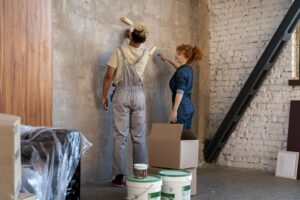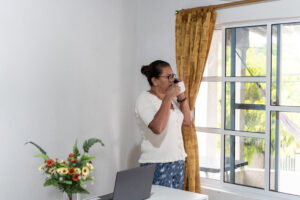
Renovations breathe new life into spaces, bringing contemporary aesthetics and improved functionality. However, the process can also introduce unwanted substances like formaldehyde, a volatile organic compound (VOC) that poses significant health risks. In this article, we will explore the effective strategies for removing formaldehyde after renovation, ensuring your spaces are as safe as they are beautiful.
Understanding Formaldehyde
Formaldehyde is a colorless, pungent-smelling gas found in many building materials and household products, including pressed-wood products (particleboard, plywood, fiberboard), insulation materials (urea-formaldehyde foam), paints, coatings, glues, adhesives, and textiles. Exposure to formaldehyde can cause eye, nose, and throat irritation, respiratory issues, and even cancer in extreme cases.
Reducing exposure is crucial, especially after renovation activities, which can elevate formaldehyde levels. Effective strategies for removing formaldehyde after renovation include proper ventilation, using air purifiers, and choosing low-formaldehyde materials.
Ventilation: The First Line of Defense

Proper ventilation is paramount in reducing formaldehyde levels. Here’s how to enhance it for removing formaldehyde after renovation:
- Open Windows and Doors: This is the simplest method for removing formaldehyde after renovation, allowing fresh air to dilute indoor formaldehyde concentrations. Do this consistently, especially in the first few weeks post-renovation.
- Use Exhaust Fans: Install and use exhaust fans in kitchens and bathrooms to expel contaminated air directly outside.
- Mechanical Ventilation Systems: For a more robust solution, consider installing a mechanical ventilation system. These systems can exchange indoor air with fresh outdoor air, significantly reducing formaldehyde levels.
Air Purifiers: Capturing Formaldehyde

Investing in high-quality air purifiers can be highly effective for removing formaldehyde after renovation. Here are key features to look for:
- HEPA Filters: High-Efficiency Particulate Air (HEPA) filters capture particulate matter, although not specifically formaldehyde, they can reduce overall indoor air pollution.
- Activated Carbon Filters: These are crucial as they adsorb VOCs, including formaldehyde. Ensure the purifier has a significant amount of activated carbon.
- Purifiers with Photocatalytic Oxidation (PCO): These use UV light to create a reaction that breaks down VOCs, including formaldehyde, into harmless components.
Plants: Nature’s Air Purifiers

Certain houseplants are known to absorb formaldehyde and other VOCs from the air. Incorporating these into your post-renovation space can be both decorative and functional. Recommended plants for removing formaldehyde after renovation include:
- Spider Plant (Chlorophytum comosum): Effective at removing formaldehyde after renovation.
- Peace Lily (Spathiphyllum spp.): Known for its air-purifying properties.
- Aloe Vera: Besides its medicinal uses, it also helps reduce formaldehyde levels.
Sealing and Encapsulation
For materials and furniture that may emit formaldehyde, consider these methods for removing formaldehyde after renovation:
- Sealing: Apply low-VOC sealants or varnishes to furniture and wood products. This creates a barrier that reduces formaldehyde emissions. Ensuring that all surfaces are thoroughly coated can significantly lower the amount of formaldehyde released into the air.
- Encapsulation: Encapsulating materials like insulation can prevent formaldehyde from escaping into the indoor air. Use vapor barriers and other encapsulation methods during installation to contain formaldehyde emissions. This technique is especially effective for insulation materials that are known to emit high levels of formaldehyde.
Humidity Control
Formaldehyde emissions increase with higher humidity and temperature. Therefore, maintaining an optimal indoor environment is crucial:
- Dehumidifiers: Use dehumidifiers to keep indoor humidity levels below 50%. This can significantly reduce formaldehyde off-gassing.
- Air Conditioning: Air conditioners not only cool the air but also reduce humidity, helping to control formaldehyde levels.
Use of Low-Formaldehyde Products
Preventive measures are just as important as remedial ones. During renovations, opt for low-formaldehyde or formaldehyde-free products:
- Furniture: Choose furniture made from solid wood or low-emitting engineered wood products. Avoid pressed wood products unless they are labeled as low-formaldehyde. Solid wood furniture not only looks great but also minimizes the risk of formaldehyde exposure.
- Paints and Coatings: Use low-VOC or no-VOC paints, stains, and finishes. These products release fewer harmful chemicals into the air. Look for products that are GreenGuard certified or have similar certifications ensuring low chemical emissions.
- Textiles: Select fabrics that are labeled as formaldehyde-free. Many textiles, especially those used in curtains, upholstery, and carpets, can contain formaldehyde. Opt for natural fibers such as cotton, wool, or linen, which are less likely to be treated with formaldehyde-based finishes.
- Flooring: Choose flooring options that are low in formaldehyde emissions. Engineered hardwood, bamboo, and certain laminate flooring options can be good choices if they meet low-formaldehyde standards. Always check for certifications like FloorScore or GREENGUARD.
- Cabinetry and Built-ins: When installing new cabinets or built-in furniture, choose products or raw materials that use formaldehyde-free or low formaldehyde adhesives and finishes. Many manufacturers like EGGER now offer formadehyle standards like ENF/F**** that are safer for indoor air quality.
Professional Testing and Remediation
To ensure your space is safe, consider professional testing:
- Formaldehyde Testing Kits: Available for purchase, these kits can provide an initial assessment of formaldehyde levels.
- Professional Testing Services: For more accurate results, hire professionals to test indoor air quality. They can provide detailed reports and recommendations.
- Remediation Services: If high levels of formaldehyde are detected, professional remediation services can implement advanced techniques to reduce indoor pollutants.
Conclusion
Removing formaldehyde after renovation is a multi-step process that involves ventilation, air purification, humidity control, and the use of low-emitting products. At EcubeSpace, we prioritize creating safe, healthy environments for our clients. By following these strategies, you can ensure your renovated spaces are free from harmful formaldehyde, providing peace of mind and a healthier living environment.
Ready to turn your dream home into reality? Book an appointment with E³.SPACE, and let us bring your vision to life.

